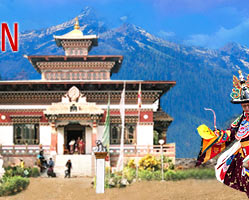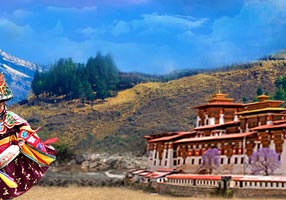While other governments around the world ensconce themselves in fortresses of stone and steel, the seat of Bhutan's Royal Government is in a building that mirrors the county's culture and its people. The Taschichho Dzong was built in the late 1700's and also serves as the home of the Central Monastic Body. The building we see today is largely a modern affair, built in 1962 when His Majesty Jigme Dorji Wangchuk moved the government to Thimphu after a fire at its original location.
The complex's central tower is original. Tashichhodzong houses the main secretariat building, throne room of His Majesty the King of Bhutan. During the warmer summer months the monk body headed by His Holiness, the Je Khenpo, makes its home in the dzong.
Religious treasure added to Tashichhodzong
With the consecration of a newly built Neten Chudrug (16 Arhats) Thongdroel by His Holiness the Je Khenpo on February 20, 2002 an invaluable religious treasure has been added to Trashichhodzong. Measuring 43 by 64 ft, the Thongdroel depicting the Buddha Shakyamuni, surrounded by his 16 followers (Arhats), was created under His Holiness' initiative. His Holiness also contributed Nu. 1.6 million to construct the Thongdroel which took six months of meticulous and painstaking work for 13 artists. It will be unfurled to the public annually on the 15th day of the 4th month of the Bhutanese calendar, coinciding with the Duechhen Ngazom (Lord Buddha's Mahaparinirvana) celebration. "The success of creating this unique masterpiece goes to the concerted efforts of embroidery master, Lopon Ugyen, and his artists who put long hours into the making of the Thongdroel," said the deputy secretary of the Dratshang Lhentshog, Ngawang Phuntsho. "If we did not put in extra efforts it would have taken at least a year or so," Lopon Ugyen, who built more than 14 various Thongdroels over the years, said.
Je Khenpo
The need for the Neten Chudrug Thongdroel was felt when His Holiness initiated a special prayer ceremony last year as an annual event on the sacred occasion of Lord Buddha's Mahaparinirvana which is celebrated all over the Buddhist world. "Since we do not have this Thongdroel in Trashichhodzong we had to hire and bring the Sangay Tsokhorsum Thongdroel all the way from Dagana dzong during the celebration of Duechhen Ngazom last year," Ngawang Phuntsho said. According to religious beliefs, a mere sight of thongdroel liberates sentient beings from the transmigratory existence through its great cleansing power.
The 16 arhats
The 16 arhats (those who had extinguished all defilements) originated from India during the time of Buddha Shakyamuni. It is believed that the Buddha entrusted his teachings to the 16 great arhats when he was about to pass away. The Buddha instructed them to remain in this world, dwell in different lands, and disseminate his teachings to benefit all sentient beings. The 16 arhats can be individually recognised by standard attributes, such as an incense burner, a fly whisk, a miniature stupa, a glowing gem, or a string of jewels. The sixteen Arhats are:
- Angaja the Arhat with a sac
- Ajita the Arhat riding a deer
- Vanavasin the Arhat under the banana tree
- Kalika the dust cleaning Arhat
- Vajriputra the persuading Arhat
- Sribhadra the Arhat who crossed the river
- Kanakavatsa the jolly Arhat
- Kanakabharadvaja the alms holding Arhat
- Bakula the silently seated Arhat
- Rahula the Arhat in deep concentration
- Gudapanthaka the door watching Arhat
- Pindola Bharadvaja the Arhat with long eyebrows
- Panthaka the Arhat with stretched arms
- Nagasena the ear cleaning Arhat
- Gopaka the scripture holding Arhat
- Abheda the stupa holding Arhat
the Guru Lhakhang in Tashichhodzong
The Neten Chudrug Thongdroel
Ceremony of Thubwang Neten Chudrug Choga
The Neten Chudrug (16 Arahats) Thongdroel has to be unfurled in a sacred ceremony to celebrate Lord Buddha's Maha-parinirvana in Tashichhodzong. As Bhutan celebrated Buddhaís Maha-parinirvana, His Majesty the King, Their Majesties the Queens, the council of ministers, and senior government officials take part the ceremony, dedicated to Buddha and his 16 followers, Neten Chudrug (16 Arahats), and offer prayers.
The Neten Chudrug Thongdroel was unfurled
in Tashichhodzong
Every year in June:
Led by His Holiness the Je Khenpo, lopon zhips and monks of the central monk body are conducting a special religious ceremony of Thubwang Neten Chudrug Choga, dedicated to Lord Buddha and his 16 followers, Arahats. Thousands of Thimphu residents also offered prayers and received blessings from the Neten Chudrug Thongdroel.
This special religious ceremony was initiated by His Holiness the Je Khenpo in 2001 with the creation of Neten Chudrug Thongdroel and the financial support from the Menjong Choethuen Tshogpa.
Neten Chudrug (16 Arahats)
The 16 arhats (those who had extinguished all defilements) originated from India during the time of Buddha Shakyamuni. It is believed that the Buddha entrusted his teachings to the 16 great arhats when he was about to pass away. The Buddha instructed them to remain in this world, dwell in different lands, and disseminate his teachings to benefit all sentient beings.
The Duechhen Ngazom (Buddha's Maha-parinirvana), is considered auspicious by all Buddhists because on the 15th day of Saga Dawa month (Bhutanese 4th month), Buddha was conceived and born, attained enlightenment, subdued demons and entered Nirvana (liberation).
According to a dratshang lhentshog's spokesman such sacred ceremony, dedicated to Guru Rinpoche, will also be introduced in Tashichhodzong. The Saga Dawa month is also called as Vaisak or Wesar in other Buddhist countries and is widely celebrated. It is beleived that one good deed or virtue done on this day will be rewarded with one hundred thousand merits.
Lord Buddha was born in 560 B.C. to Suddhodana, king of the Sakhyas and Maya who died seven days after her son's birth in Lumbini, near the city of Kapilavastu in Nepal. He died at the age of eighty in 480 B.C. in Kusinagara, India.
Tashichhodzong's Guru Lhakhang consecrated
With major renovations completed recently, the 117-year old Guru Lhakhang in the Tashichhodzong was consecrated on December 9, 2003 by His Holiness the Je Khenpo at a ceremony attended by His Royal Highness the Crown Prince, Dasho Jigme Khesar Namgyal Wangchuck, their Majesties the Queens and the Council of Ministers .
The Nu 9.7 million renovation project was done by Thimphu dzongkhag in consultation with the national commission for cultural affairs (NCCA). Except for the lhakhang's chhoekhang which houses the main images, and the main wall, all the old wooden structures of the lhakhang were replaced.
The renovation work was started in March 2001. The Guru Lhakhang was built by the Thimphu dzongpon, Kunzang Thinley in 1886 under the instruction of Desi Jigme Namgyal.
The Neten Chudrug thongdroel unfurled at the outer wall of the Guru Lhakhang in Tashichodzong
The lhakhang houses images like the Guru Nangsi Zilnon (complete triumph over all illusory appearances), the Guru Tshengyed (eight manifestations of Guru Padmasambhava) and the Gongdue Lhatshog (images of Abhipraya Samaja). The Guru Lhakhang is also known as Lhakhangsarp (new temple) because it was built 114 years after the construction of the Tashichhodzong.
In 1216, Lama Lhakpa Rinchen Gyalpo built the Dho-Ngen (blue stone) dzong on a hill above Thimphu where Dechenphhodrang now stands. The dzong was offered to Zhabdrung Ngawang Namgyal by one of the descendants of Lam Lhakpa in 1641.
The Zhabdrung renamed it Tashichhodzong (fortress of glorious religion) and it served as the summer residence of the Central Monk Body which was established in Punakha. It was destroyed by fire during the time of the 16th Desi, Sonam Lhendup, popularly known as Zhidar in 1772.
Tashichhodzong was relocated to its present site and rebuilt to accommodate both the civil officials and monks. A smaller monastery was built at the original site and renamed Dechhenphodrang.
Between 1962-1969, King Jigme Dorji Wangchuck completely renovated and enlarged the dzong. Unlike most other dzongs, Tashichhodzong has two main entrances.




